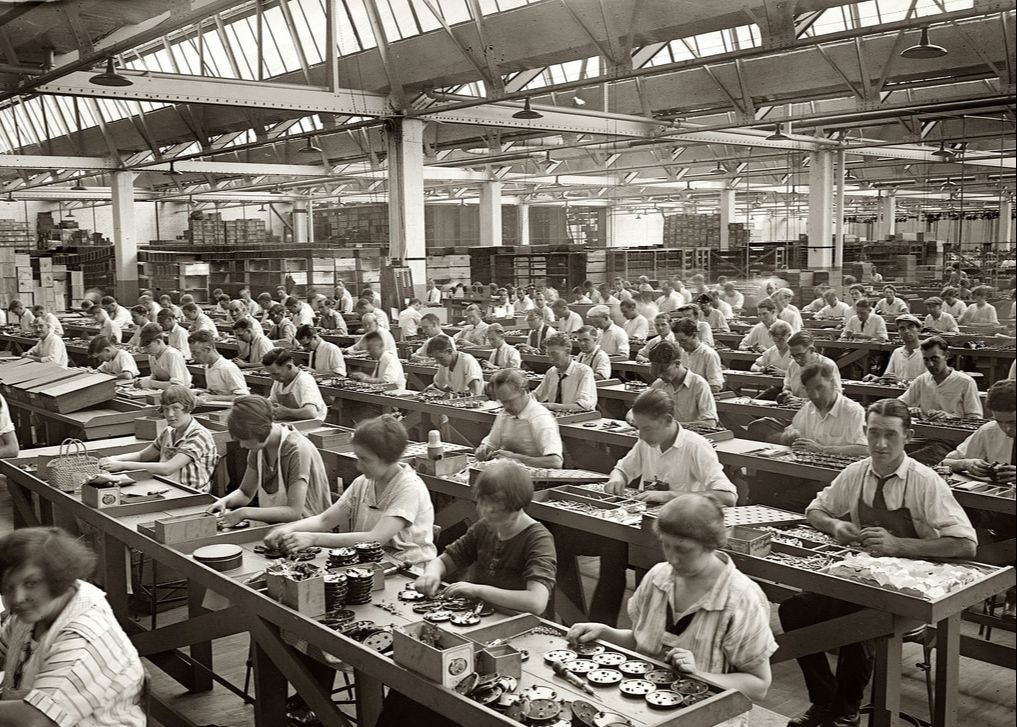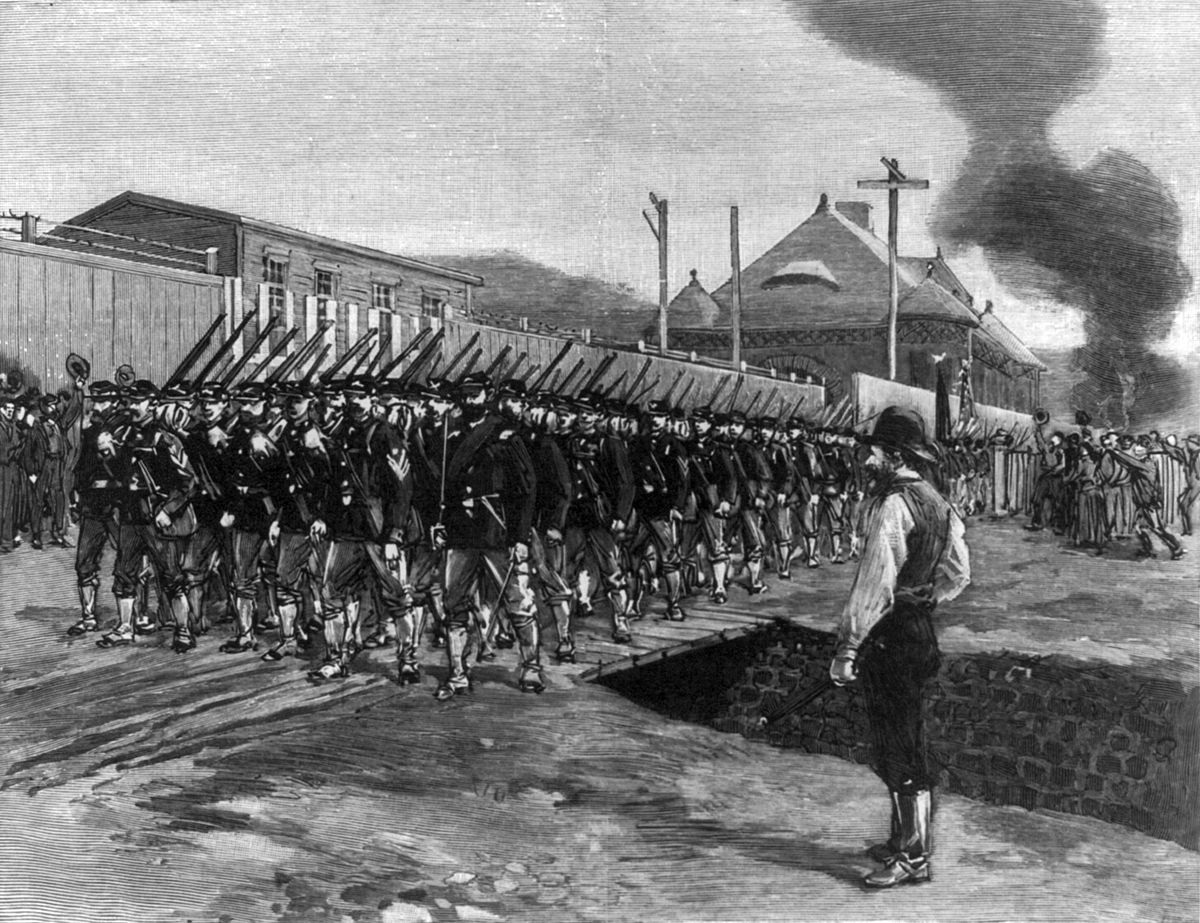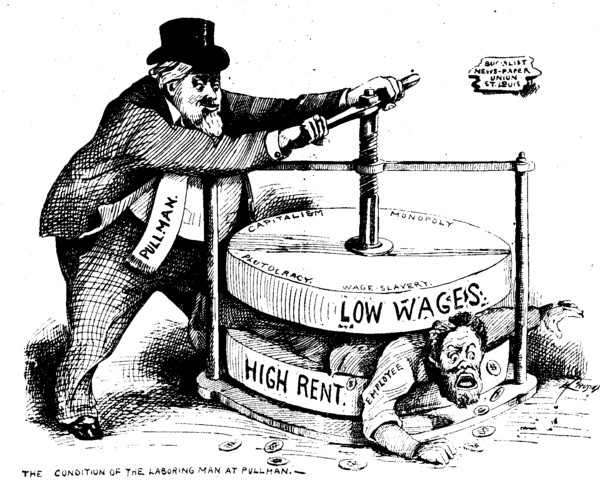Crap-tastic life
Life during the Industrial Revolution was pretty rough for the average worker in the US and UK. Workers would work in factories for fourteen to sixteen hours a day for 6 days a week and would only be paid for $8 to $10 dollars a week. Women were paid less, and children were paid less even more. There was little to no sunlight in the workplace, and machines didn’t have any safety precautions which resulted in injuries. Pollution was a major problem as workers would be covered in soot or have soot in their lungs. To make matters worse, living conditions were also pretty miserable. Workers would have to live in tightly spaced apartments where six to nine people would be crammed into a tiny room, making it easy for diseases like cholera to spread in spaces that had no sanitation. It was pretty clear that factory owners and bosses had little interest in supporting workers and only cared about their own personal profit. Besides, if a worker couldn’t work or doesn’t want to work, then the managers could easily replace a worker with someone else and not offer any benefits. This was the Industrial Revolution where CEOs could make the decisions, income inequality was high, and people were desperate to find any job to earn a little money.

Factory workers in the Industrial Revolution

An example of child labour in the Industrial Revolution. Notice that the children are working with bare hands and have no protection
A rough start
With the terrible conditions, it was pretty clear that enough was enough for workers. The first labour unions appeared in Britain and the US in the 19th century but were very sporadic and short-lived. Because of the hostility from employers and government groups, unions were regularly prosecuted if they tried to protest. Eventually, the UK would pass new reforms in the late 19th century to help aid workers from terrible business practices with a new political party called the Labour Party being made to represent the workers. By the early 20th century, labour unions became a strong political force in the UK. But the US was still slow when creating reforms. Workers protests in the tended to be very violent. For example, the Homestead Strike in the US in 1892 saw a battle between workers and private security agents. Henry Clay Frick, the manager of the steel mill which was owned by business tycoon Andrew Carnegie, wanted to break labour unions and decided to lock out the members of Amalgamated Association of Iron and Steel Workers (AA). In response, the workers put on a strike at the plant. Frick hired strikebreakers(commonly nicknamed as scabs at the time) which were actually part of a private ‘detective’ agency that hired armed men. Around 300 armed men would fire at the workers causing violence on both sides but in the end, the workers won… until the Pennsylvania governor decided to dispatch 6000 men from the state’s militia to put down the union. Another famous workers’ strike was the Pullman strike in 1894 where workers would protest for better wages after George Pullman, the inventor of the sleeping car, reduced wages during an economic downturn. The workers were led by famous American Socialist, Eugene V Debs(the Bernie Sanders before Bernie was even born) but he along with others were arrested. The company put US mail onto the trains and since the workers were striking, they prevented the trains from moving. US President Grover Cleveland saw this as a threat to US mail and dispatched troops to stop the union. Those who were arrested were taken into court where the judges sided with the employers.

Pennsylvania state militia coming to stop union protests

A political cartoon of the Pullman Strike
Time for change
Any attempts to make reforms usually ended in a failure. Although some laws were put in place that helped reduce some power of corporations like the Sherman Anti-Trust which reduced monopolies and laws that helped women and child labourers, most of the economic power in the US was still mostly held by large companies. Things started to change when Theodore Roosevelt became President in 1901. Unlike his predecessors, Roosevelt was very progressive for the time and cared about workers. His “Square Deal” was a new policy that greatly reduced the power of large companies and prevented trusts which earned Roosevelt the nickname “trust buster”. In 1902, coal miners in Pennsylvania went on strike to demand for better pay, shorter work hours, and better conditions. Tycoon JP Morgan tried to intervene but Roosevelt decided to step in and have an emergency meeting between the workers’ representatives and the businessmen. Roosevelt was more sympathetic to the workers and wanted to resolve the issue more peacefully. This marked a change in US policy where strikes were now handled peacefully instead of violence like previous attempts. After hearing from testimonies and looking at evidence, Roosevelt granted workers better pay, hours, and conditions. This marked a major victory for labour unions in the US, and there would be more to come. In 1905, a union called Industrial Workers of the World(IWW) was formed in 1905 by William Haywood. The union hired skilled and unskilled workers and had the goal of not only improving workers lives but to also try to end capitalism. The group adhered to Marxism and Anarchism, and unlike other American socialists who wanted to use electoral votes to gain influence, the IWW believed that sabotage would be the solution. The IWW numbers would grow later on and be one of the most influential labour unions in the US but despite this, they never achieved their goals. In 1903, the Women’s Trade Union League was formed with the purpose to help women receive a better education and work conditions. The League would become influential later on as they helped manage to pass 8 hour work day, end child labour, set a minimum wage, and after the terrible Triangle Shirtwaist Fire, better regulations. Labour unions in the US don’t have the same influence today compared to Europe or late 19th to early 20th century America. But they are still an important part of history and are the main reasons why safety standards exist.

US President Roosevelt meeting with representatives of the coal union to help solve the issue

A convention of the Women’s Trade Union League

An IWW poster
Lecture Summary
In this lesson, we learned about a big evolution in poster design where new artists started to create unique styles. One of the new styles was art nouveau which was derived from the arts and crafts movement after the designers found out that they need a more accessible way for people to enjoy their work. Famous artists such as Aubrey Beardsley, Charles Ricketts, Charles Mackintosh and his friends, as well as others, would become well known for their designs in art and architecture. We also saw new scientific discoveries such as Marconi sending the first radio message, Albert Einstein’s theory of relativity, Freud’s book on dreams, and the Lumiere Brother producing the first cinematic film. I overall thought that this class was the most interesting compared to previous time periods. The main reason is because in older eras, art and design was still very traditional and complex and even though there were several different art movements, the artworks mostly felt that they had to depict life like it was reality. But in this period, we get to see art that strays away from that traditionalism. While some aspects of the old teaching do exist, the influence from Japanese art created a new style in the West, where less colours and more dynamic yet simple scenes were made, and to me, that style really had an impact on me because it shows how design and illustration can come together perfectly by being both complex and simple at the same time.
Sources
https://firstindustrialrevolution.weebly.com/working-and-living-conditions.html
https://www.britannica.com/topic/trade-union
https://www.khanacademy.org/humanities/us-history/the-gilded-age/gilded-age/a/labor-battles-in-the-gilded-age
https://www.history.com/topics/us-presidents/theodore-roosevelt
https://www.theodorerooseveltcenter.org/Learn-About-TR/TR-Encyclopedia/Capitalism-and-Labor/Anthracite-Coal-Strike
https://www.u-s-history.com/pages/h1050.html
https://www.workersliberty.org/story/2012/02/15/new-unionism-1880s
https://www.britannica.com/topic/Womens-Trade-Union-League
Images
https://www.historycrunch.com/working-conditions-in-the-industrial-revolution.html#/
https://www.smore.com/j5b8-industrial-revolution-conflicts
https://en.wikipedia.org/wiki/Pullman_Strike#/media/File:The_Condition_of_Laboring_Man_at_Pullman_1894.jpg
https://en.wikipedia.org/wiki/Homestead_strike
http://www.chronline.com/news/this-day-in-vigilantes-attack-hoquiam-industrial-workers-of-the/article_ed06cefc-cb31-11e7-b56a-fb65a5b7bf81.html
https://potus-geeks.livejournal.com/883928.html
https://www.britannica.com/topic/Womens-Trade-Union-League
Leave a Reply